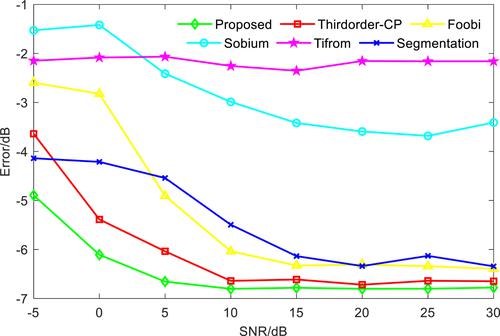当前位置:
X-MOL 学术
›
IET Radar Sonar Navig.
›
论文详情
Our official English website, www.x-mol.net, welcomes your feedback! (Note: you will need to create a separate account there.)
Underdetermined blind source separation based on third-order cumulant and tensor compression
IET Radar Sonar and Navigation ( IF 1.7 ) Pub Date : 2024-03-22 , DOI: 10.1049/rsn2.12553 Weilin Luo 1 , Xiaobai Li 1 , Hongbin Jin 2 , Hao Li 1 , Kai Yuan 1 , Ruijuan Yang 1
IET Radar Sonar and Navigation ( IF 1.7 ) Pub Date : 2024-03-22 , DOI: 10.1049/rsn2.12553 Weilin Luo 1 , Xiaobai Li 1 , Hongbin Jin 2 , Hao Li 1 , Kai Yuan 1 , Ruijuan Yang 1
Affiliation

|
A method for Underdetermined Blind Source Separation is proposed using third-order cumulants and tensor compression. To effectively suppress symmetrical distributed noise, the third-order cumulant is considered. Additionally, the complexity of high-dimensional tensors can be reduced through high order singular value decomposition (HOSVD) for compression purposes. The method begins by calculating the third-order cumulant tensor for whitening signals at different time delays, and then stacks several cumulants into a fourth-order tensor. The HOSVD decomposition is applied to the fourth-order tensor, compressing the high-dimensional tensor into a low-dimensional core tensor. Next, the core tensor is further decomposed using the canonical polyadic decomposition, and the resulting factor matrices are fused to obtain an estimation of the mixed matrix. Finally, leveraging the signal independence, a matrix diagonalisation method is employed to recover the source signals. Theoretical analysis and simulation results demonstrate that the proposed method effectively suppresses the influence of Gaussian noise, reduces computational complexity, and saves computational time. Moreover, compared with five representative approaches, the proposed method achieves superior separation results. Specifically, for the 3 × 4 mixed model with a signal-to-noise ratio of 20 dB, the average relative error of speech signal and radio signal are −11.02 and −6.8 dB respectively.
中文翻译:

基于三阶累积量和张量压缩的欠定盲源分离
提出了一种使用三阶累积量和张量压缩的欠定盲源分离方法。为了有效抑制对称分布噪声,考虑了三阶累积量。此外,为了压缩目的,可以通过高阶奇异值分解(HOSVD)来降低高维张量的复杂性。该方法首先计算不同时间延迟下白化信号的三阶累积量张量,然后将几个累积量堆叠成四阶张量。 HOSVD分解应用于四阶张量,将高维张量压缩为低维核心张量。接下来,使用规范多元分解进一步分解核心张量,并将所得因子矩阵融合以获得混合矩阵的估计。最后,利用信号独立性,采用矩阵对角化方法来恢复源信号。理论分析和仿真结果表明,该方法有效抑制了高斯噪声的影响,降低了计算复杂度,节省了计算时间。此外,与五种代表性方法相比,该方法取得了优异的分离结果。具体来说,对于信噪比为20 dB的3×4混合模型,语音信号和无线电信号的平均相对误差分别为-11.02和-6.8 dB。
更新日期:2024-03-25
中文翻译:

基于三阶累积量和张量压缩的欠定盲源分离
提出了一种使用三阶累积量和张量压缩的欠定盲源分离方法。为了有效抑制对称分布噪声,考虑了三阶累积量。此外,为了压缩目的,可以通过高阶奇异值分解(HOSVD)来降低高维张量的复杂性。该方法首先计算不同时间延迟下白化信号的三阶累积量张量,然后将几个累积量堆叠成四阶张量。 HOSVD分解应用于四阶张量,将高维张量压缩为低维核心张量。接下来,使用规范多元分解进一步分解核心张量,并将所得因子矩阵融合以获得混合矩阵的估计。最后,利用信号独立性,采用矩阵对角化方法来恢复源信号。理论分析和仿真结果表明,该方法有效抑制了高斯噪声的影响,降低了计算复杂度,节省了计算时间。此外,与五种代表性方法相比,该方法取得了优异的分离结果。具体来说,对于信噪比为20 dB的3×4混合模型,语音信号和无线电信号的平均相对误差分别为-11.02和-6.8 dB。



























 京公网安备 11010802027423号
京公网安备 11010802027423号